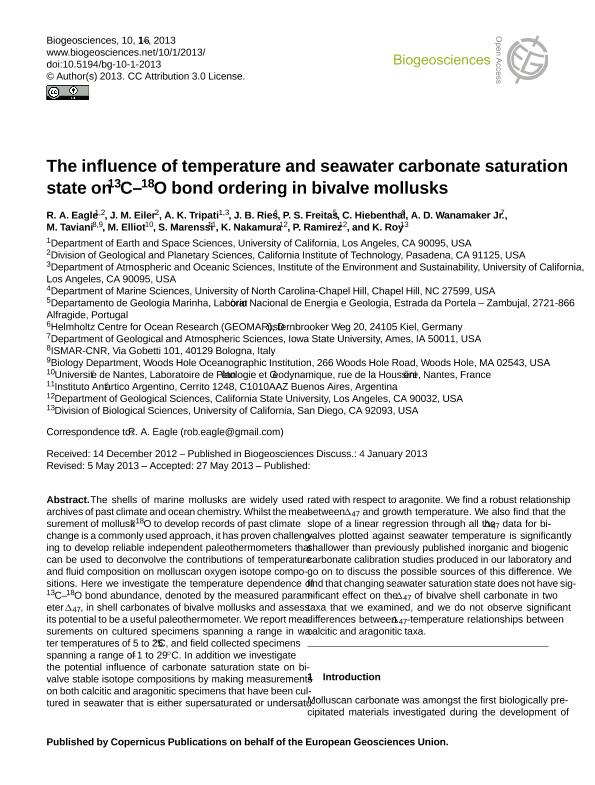Mostrar el registro sencillo del ítem
dc.contributor.author
Eagle, R. A.
dc.contributor.author
Eler, J. M.
dc.contributor.author
Tripati, A. K.
dc.contributor.author
Res, J. B.
dc.contributor.author
Freitas, P. S.
dc.contributor.author
Heibental, C .
dc.contributor.author
Wanamaker, A. D., Jr.
dc.contributor.author
Taviani, M.
dc.contributor.author
Elliot, M.
dc.contributor.author
Marenssi, Sergio Alfredo

dc.contributor.author
Nakamura, K.
dc.contributor.author
Ramirez, P.
dc.contributor.author
Roy, K .
dc.date.available
2017-01-09T21:57:18Z
dc.date.issued
2013-05
dc.identifier.citation
Eagle, R. A.; Eler, J. M.; Tripati, A. K.; Res, J. B.; Freitas, P. S.; et al.; The influence of temperature and seawater carbonate saturation state on 13C-18O bond ordering in bivalve mollusks; Copernicus Publications; Biogeosciences; 10; 5-2013; 4591-4606
dc.identifier.issn
1726-4170
dc.identifier.uri
http://hdl.handle.net/11336/11018
dc.description.abstract
The shells of marine mollusks are widely used archives of past climate and ocean chemistry. Whilst the measurement of mollusk δ 18O to develop records of past climate change is a commonly used approach, it has proven challenging to develop reliable independent paleothermometers that can be used to deconvolve the contributions of temperature and fluid composition on molluscan oxygen isotope compositions. Here we investigate the temperature dependence of 13C–18O bond abundance, denoted by the measured parameter 147, in shell carbonates of bivalve mollusks and assess its potential to be a useful paleothermometer. We report measurements on cultured specimens spanning a range in water temperatures of 5 to 25 ◦C, and field collected specimens spanning a range of −1 to 29 ◦C. In addition we investigate the potential influence of carbonate saturation state on bivalve stable isotope compositions by making measurements on both calcitic and aragonitic specimens that have been cultured in seawater that is either supersaturated or undersaturated with respect to aragonite. We find a robust relationship between 147 and growth temperature. We also find that the slope of a linear regression through all the 147 data for bivalves plotted against seawater temperature is significantly shallower than previously published inorganic and biogenic carbonate calibration studies produced in our laboratory and go on to discuss the possible sources of this difference. We find that changing seawater saturation state does not have significant effect on the 147 of bivalve shell carbonate in two taxa that we examined, and we do not observe significant differences between 147-temperature relationships between calcitic and aragonitic taxa.
dc.format
application/pdf
dc.language.iso
eng
dc.publisher
Copernicus Publications

dc.rights
info:eu-repo/semantics/openAccess
dc.rights.uri
https://creativecommons.org/licenses/by-nc-sa/2.5/ar/
dc.subject
Stable Isotopes
dc.subject
Paleotemperatures
dc.subject
Shells
dc.subject.classification
Geoquímica y Geofísica

dc.subject.classification
Ciencias de la Tierra y relacionadas con el Medio Ambiente

dc.subject.classification
CIENCIAS NATURALES Y EXACTAS

dc.title
The influence of temperature and seawater carbonate saturation state on 13C-18O bond ordering in bivalve mollusks
dc.type
info:eu-repo/semantics/article
dc.type
info:ar-repo/semantics/artículo
dc.type
info:eu-repo/semantics/publishedVersion
dc.date.updated
2016-11-24T18:38:16Z
dc.identifier.eissn
1726-4189
dc.journal.volume
10
dc.journal.pagination
4591-4606
dc.journal.pais
Alemania

dc.journal.ciudad
Gottingen
dc.description.fil
Fil: Eagle, R. A.. University of California; Estados Unidos. California Institute of Technology; Estados Unidos
dc.description.fil
Fil: Eler, J. M.. California Institute of Technology; Estados Unidos
dc.description.fil
Fil: Tripati, A. K.. University of California; Estados Unidos
dc.description.fil
Fil: Res, J. B.. University Of North Carolina; Estados Unidos
dc.description.fil
Fil: Freitas, P. S.. Laboratorio Nacional de Energia e Geologia; Portugal
dc.description.fil
Fil: Heibental, C .. Geomar-helmholtz Centre For Ocean Research Kiel; Alemania
dc.description.fil
Fil: Wanamaker, A. D., Jr.. University of Iowa; Estados Unidos
dc.description.fil
Fil: Taviani, M.. Consiglio Nazionale Delle Ricerche. Istituto di Scienze Marine; Italia. Woods Hole Oceanographic Institution; Estados Unidos
dc.description.fil
Fil: Elliot, M.. Universite de Nantes; Francia
dc.description.fil
Fil: Marenssi, Sergio Alfredo. Ministerio de Relaciones Exteriores, Comercio Interno y Culto. Dirección Nacional del Antártico. Instituto Antártico Argentino; Argentina. Consejo Nacional de Investigaciones Científicas y Técnicas; Argentina
dc.description.fil
Fil: Nakamura, K.. California State University; Estados Unidos
dc.description.fil
Fil: Ramirez, P.. California State University; Estados Unidos
dc.description.fil
Fil: Roy, K .. University of California; Estados Unidos
dc.journal.title
Biogeosciences

dc.relation.alternativeid
info:eu-repo/semantics/altIdentifier/url/http://www.biogeosciences.net/10/4591/2013/
Archivos asociados
